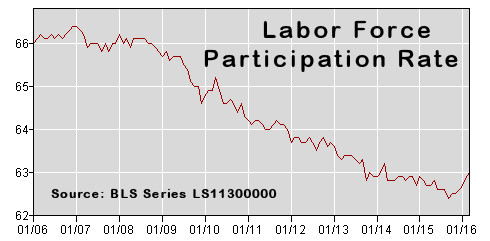The U.S. Bureau of Labor Statistics (BLS) released their employment data for the month of March 2016. The adjusted U-3 unemployment rate was 5.0% up from 4.9% in February. The unadjusted U-3 unemployment rate was 5.1% while the Gallup survey says the unadjusted U-3 was actually a full 1% higher at 6.1%. See: Unemployment Rate Chart
U-6 Unemployment
The BLS says the broader U-6 unemployment rate that includes short term “discouraged workers” was 9.9% while Gallup says the rate is really 14.4%.
Meanwhile, according to Shadowstats the government is really underestimating unemployment by even more since “long-term discouraged workers were defined out of official existence in 1994.” According to Shadowstats the real U-6 unemployment rate is 22.9%.
Jobs Gains
The BLS reported a gain of 215,000 jobs in March while the payroll processing company ADP which also tracks jobs numbers says the gain was only 205,000. The ADP report also revised February’s job gains down to 205,000, which is lower than the 242,000 gain reported by the Bureau of Labor Statistics for February.
Employment
Total employment according to BLS is 142.877 million up from January 2016’s 141.155 million. Employment is still below November and June of 2015’s previous peaks of 144.122 million and 142.836 million respectively. See Employment Chart
Labor Force Participation Rate
The BLS says that 63% of the 252.768 million civilian non-institutional population is currently in the workforce (i.e. working or looking for a job). Although the U-3 unemployment rate has returned to near 2008 levels the Labor Force Participation rate (LFPR) has fallen drastically since 2008. This indicates that many people have left the official workforce and joined the ranks of the uncounted “long-term discouraged workers”. It could also indicate an increase in those joining the ranks of the retired but the data does not support this conclusion see Record Low LFPR which shows the LFPR by age group since 1999. The biggest declines occur in the younger ages while those above age 60 actually show a higher percentage are working. For instance in 1999 only 24% of those age 65-69 were working but 14 years later 31% of those age 65-69 were working.
Gallup “Good Jobs” Index
Gallup says 44.4% of the total adult population has a full-time job. This does not mean that they are employed at their full capacity or that they are earning a “decent wage” simply that they are employed . Gallup defines a good job as 30+ hours per week for an employer who provides a regular paycheck. Gallup Good Jobs is calculated as a percentage of the total population. Gallup says “What the whole world wants is a good job… Good jobs are essential to a thriving economy, a growing middle class, a booming entrepreneurial sector and, most importantly, human development. Creating as many good jobs as possible should be the No. 1 priority for business and government leaders everywhere.”
Of course we know government can not really create good jobs because the government does not create anything it simply takes so government jobs are paid for by taking money from the private sector thus reducing the number of private sector jobs and actually due to “slippage” creating fewer jobs than the private sector would have if left alone.
The only thing the government can do is to create an environment friendly to the private sector with minimal regulations that will allow small businesses to create new jobs. See: The Six Contradictions of Socialism in America and The Socialist Time Capsule for more information.

